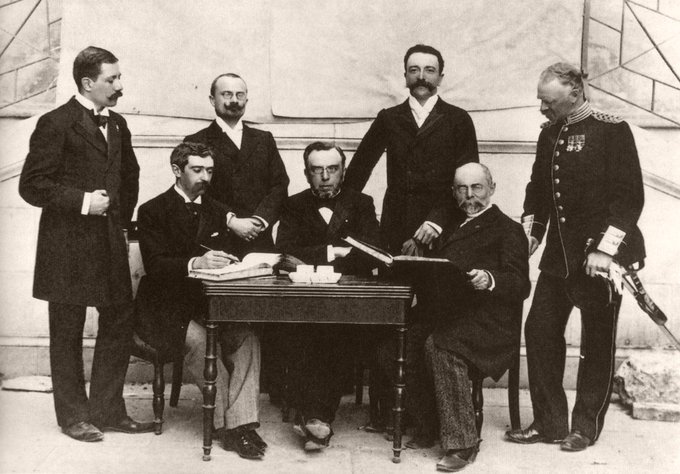Clutching At A Straw: New Zealand’s introduction to the modern Olympics
0By Jamie Bell
In 1894, Baron Pierre de Coubertin, invited delegates from around the world to the Congress on the Revival of the Olympic Games in Paris. On June 23 1894, the Congress passed a resolution to revive the Olympic Games, starting with Athens in 1896.
New Zealand’s involvement in the establishment of the modern Olympics began in 1892 when the New Zealand Amateur Athletics Association (NZAAA) toured to England and Paris. Among the NZAAA contingent was Leonard Cuff, who was both a competitor and the team manager. Cuff’s sporting CV is long and includes cricket (where he captained the first, unofficial, New Zealand side), baseball, rugby, golf, and lawn bowls.
While the NZAAA team was in Paris, Cuff met Pierre de Coubertin who was, at the time, the General Secretary of the Union des Sociétés Françaises Sports Athlétiques (USFSA). Little is known of the interactions between the pair, but, although they would never meet in person again, a relationship was borne. Letters between the pair highlight the fondness with which Cuff remembers his time in Paris.
de Coubertin was impressed enough by Cuff to invite him to his 1894 Congress. Although he could not attend the Paris meeting, Cuff was still asked to be one of the 13 members of the inaugural International Olympic Committee. Cuff’s association with the IOC would run through to 1905, during which time he never attended a meeting and no official teams from the area he represented (Australasia) competed.
In 1908 that all changed as New Zealand and Australia combined to send an official team to the Olympics for the first time. The 32-strong group of athletes sent to London included just three New Zealanders. The Amateur Athletic Union of Australasia (AAUA) was responsible for selecting the 1908 team. Established in 1897, under the guidance of Richard Coombes, the AAUA were the major driving force towards Australasia attending the Olympics.
In July 1911, the Dunedin Centre of the NZAAA passed a motion resolving that it was time for New Zealand to seek separate representation at the Olympics. In order to build support for their case, they sent a letter to the other regional centres of the NZAAA as well as to several other sporting groups. Although the response was largely favourable, the general opinion was that separate representation was too expensive for New Zealand. Several responses lightheartedly mocked the lack of financial foresight from the Otago instigators and challenged them to come up with a scheme.
The seed had been planted, however, and the NZAAA held a meeting in September focused on the proposition. Unfortunately for those seeking separation, the meeting did not go well. It is perhaps best described in the words of the man who chaired it, GS Hill, who was himself in favour of the proposition.
“I was like a drowning man clutching at a straw. The heavy artillery was bombarding me right and left, and in the end I was riddled with shot … Any chance of converting the meeting in favor of the proposal was killed by the opposition of Messrs Marryatt and Pollock.“
– GS Hill quoted in the Evening Star, 14 October 1911
The sports’ loving people of Otago again went on the front foot, establishing the Otago Olympic and International Executive. Where they had previously only sought support from established Olympic sports, they broadened this in November 1911, sending letters asking for delegates from every national sporting body. Among those to receive a copy of the letter and its plea for support was the New Zealand Cricket Council (NZCC).
The Otago group hosted a meeting in Wellington, to which the NZCC sent their representatives based in the capital, Martin Luckie and Ernest Vance. In his letter to the men, NZCC secretary Frederick Charles Raphael, noted that the “committee was quite ignorant of the proposed constitution […] and of course we do not know whether it would be wise to join any such body”. Luckie and Vance were given the instruction to report back on their findings, however, no further correspondence is recorded. The NZCC would again flirt with Olympic matters in 1920 when the Canterbury Olympic Games Council requested cricket representation.
Among the Australasian athletes at Stockholm was Wimbledon champion and First-Class cricketer, Anthony Wilding.
While he won bronze on that occasion, he could’ve been in contention at London in 1908 too – a clerical error omitted his name from the nominations.
Just as they did when the Dunedin Centre first put forward the 1911 proposal, the NZAAA responded quickly to the November challenge, formalising the first New Zealand Olympic Committee (NZOC). As the major criticism around New Zealand sending its own Olympic team had been cost and, specifically, how to raise the funds necessary, the first NZOC had a clear mandate. However, with Stockholm looming, the only fundraising to be done was in getting athletes to the 1912 Games. As they had four years earlier, New Zealand again sent three athletes who were joined by 23 Australians to complete the Australasian team.
The inaugural New Zealand Olympic Committee realised very early on that they had another problem altogether, they were not recognised by the International Olympic Committee (IOC). This forced a number of meetings with their Australian counterparts as they attempted to find a resolution where their voice would be heard, even though they competed alongside Australia. In the end, the intervention of WWI meant these discussions became insignificant.
As the world emerged from war in 1918, the IOC held a conference in Lausanne, Switzerland, to determine the venue and date for the return of the Olympic Games. At the same meeting it was proposed that New Zealand become a competing nation in its own right. A year later, the confirmation of Antwerp as the venue for the 1920 Games came alongside another note from the IOC, New Zealand athletes would finally stand under their own flag.
Follow Jamie on Twitter

